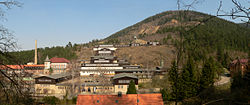Goslar | |
|---|---|
Top: Rammelsberg Middle: City centre. Bottom: Kaiserpfalz | |
Location of Goslar within Goslar district  | |
| Coordinates: 51°54′26″N 10°25′48″E / 51.90722°N 10.43000°E | |
| Country | Germany |
| State | Lower Saxony |
| District | Goslar |
| Subdivisions | 18 districts |
| Government | |
| • Lord mayor (2021–26) | Urte Schwerdtner[1] (SPD) |
| Area | |
• Total | 163.71 km2 (63.21 sq mi) |
| Elevation | 255 m (837 ft) |
| Population (2022-12-31)[2] | |
• Total | 50,203 |
| • Density | 310/km2 (790/sq mi) |
| Time zone | UTC+01:00 (CET) |
| • Summer (DST) | UTC+02:00 (CEST) |
| Postal codes | 38640, 38642, 38644 |
| Dialling codes | 05321, 05325 |
| Vehicle registration | GS |
| Website | www.goslar.de |
| UNESCO World Heritage Site | |
|---|---|
 View to the North with the Hildesheim downs in the background. Photograph taken from the Maltermeister Tower | |
| Part of | Mines of Rammelsberg, Historic Town of Goslar and Upper Harz Water Management System |
| Criteria | Cultural: i, iv |
| Reference | 623-001 |
| Inscription | 1992 (16th Session) |
| Extensions | 2010 |
| Area | 363.3 ha |
| Buffer zone | 376.1 ha |
Goslar (German pronunciation: [ˈɡɔslaʁ]; Eastphalian: Goslär) is a historic town in Lower Saxony, Germany. It is the administrative centre of the district of Goslar and is located on the northwestern slopes of the Harz mountain range. The Old Town of Goslar with over 1.500[3] timber houses and the Mines of Rammelsberg are UNESCO World Heritage Sites for their millennium-long testimony to the history of ore mining and their political importance for the Holy Roman Empire and Hanseatic League.[4] Each year Goslar awards the Kaiserring to an international artist, called the "Nobel Prize" of the art world.[5]
- ^ "Stichwahlen zu Direktwahlen in Niedersachsen vom 26. September 2021" (PDF). Landesamt für Statistik Niedersachsen. 13 October 2021.
- ^ "LSN-Online Regionaldatenbank, Tabelle A100001G: Fortschreibung des Bevölkerungsstandes, Stand 31. Dezember 2022" (in German). Landesamt für Statistik Niedersachsen.
- ^ "Fachwerkhäuser und prominente Besucher: Goslar ist eine reale Filmkulisse - WELT". DIE WELT (in German). 2021-05-17. Retrieved 2024-04-19.
- ^ "Mines of Rammelsberg, Historic Town of Goslar and Upper Harz Water Management System". UNESCO World Heritage Centre. United Nations Educational, Scientific, and Cultural Organization. Retrieved 25 Jun 2022.
- ^ "Kaiserring | Mönchehaus Museum Goslar". Retrieved 2020-01-05.






